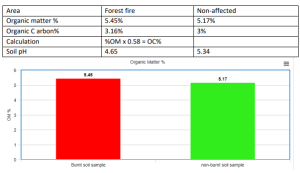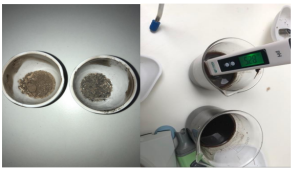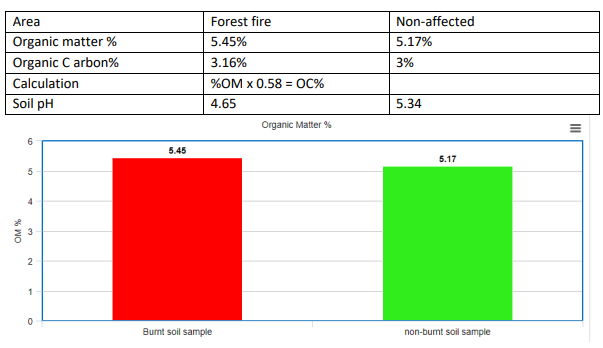Climate Detectives Projects 2022-2023
Project title: The long-term effects of forest fires in our locality
Team: CANT
Clonaslee College Clonaslee Ireland 4 Student’s age: 16-17 years old
What are the long-term effects of forest fires on biodiversity, specifically soil – What effects do they have on the soil pH and organic matter percentage?

We all have a vivid memory of the widespread forest fire across the Slieve Bloom Mountains, that
occurred in the summer of 2018, and have wondered what long term effects have come from this
disaster that occurred in our locality. After researching this topic on local newspapers like Laois
Today and RTÉ news archives, we discovered that the cause of the fire was unnatural, but due to
drought and dry weather increased by climate change, the fire escalated quickly. The fire originally
started near Ballyfin and quickly spread across over one hundred hectares of forestry in the Slieve
Bloom Mountains. The gorse burned in the fire previously played a massive role in the biodiversity
of the mountains. This was a great loss of habitats in the area. We have decided to look further into
this local event – an unnatural disaster with increased effects due to climate change. Through this,
we will get a better understanding of the long-term effects of forest fires on soil while also learning
more about our locality. We plan to investigate by taking soil samples from the area where the fire occurred and compare it
to soil from elsewhere in the mountains that was not reached by the fire to use for comparison in
our investigation. We want to use an auger to take even samples of the soil in both areas to check
and compare the soil pH and organic matter percentage. Forest fires are inevitable, and we would
like to research the long-term effects they leave behind to figure out solutions for the issue. We
would also look at the biodiversity in the area, both before and after, by researching the areas that
were affected by the fire and go out to conduct field research in these areas where the effects of
the fire can still be seen today.

After collecting all our samples, we brought them back to the science lab for analysis. For our first
test, we looked at comparing the soil pH in each sample. We took two beakers – one with buffer 4,
one with buffer 10 – to check if the pH metre was working accurately. Once we knew our utensil
was trustworthy, we commenced the investigation. We first took 25g of a burnt sample and placed
it in an empty beaker, along with 100ml of distilled water. We mixed the soil and water to make a
solution and placed our pH metre in the beaker along with it. Next, we took our non-burnt sample
and placed this in a beaker with 100ml of distilled water, to keep our investigation fair. For our next
test, we put even amounts of the burnt soil and the non-burnt soil into two separate crucibles. We
then placed two pipe clay triangles on two separate tripod stands and added a Bunsen burner
below each of these. We placed the two crucibles of soil over the heat and waited for them to
burn. After both samples were burnt, we took them off the heat and weighed them. After burning,
the non-burnt soil sample lost 0.47 whereas the burnt sample only lost 1.06g. Here, we also
noticed a distinct difference in their colour – The soil originally burnt in the forest fire was much
lighter than the non-burnt soil from the mountains. Through these investigations we could
distinctively identify the differences between the soils. In addition, we also calculated the organic
carbon percentage in both soils as a strong correlation exists between climate change carbon
sequestration in soil.

We can conclude our investigation with confidence that we have answered our research
question. We have gathered information on the soil’s pH, organic matter percentage and
additionally on its organic carbon percentage. From this, we can see that when the forest
fire occurred, the soil’s pH levels dropped. This is due to the addition of acidic ions in the
ash being deposited and integrated into the soil.
We also noticed that the organic matter percentage increased. This is because the burning
of the plants and animals helped speed up the decomposing process. If we were to do this
test again, we would look at more differences in the soils after a forest fire, like the
flocculation, soil texture or the cation exchange. We would also like to compare our results
with data from other forest fires in the country, to see if they also had similar results. We
understand the dangers of forests fires have now been increased as a result of drought and
dry weather due to climate change.
To decrease the impact of a forest fire, we believe that forest buffers should be put in
place. A riparian forest buffer is an area adjacent to a stream, lake, or wetland that
contains a combination of trees, shrubs, or other perennial plants and is managed
differently from the surrounding landscape, to provide conservation benefits. If a forest
fire was to break out, these buffers would slow the spreading and contaminate the flames.
These forest buffers will lessen the short-term damages and long-term impacts left by
future forest fires. We understand the inevitability of wildfires, whether they are naturally
or unnaturally occurred, and therefore there is no complete solution to the issue we have
identified, but we believe that forest buffers are the best way to minimise the impacts.
Projects are created by the teams and they take the full responsibility of the shared data.
← All projects





